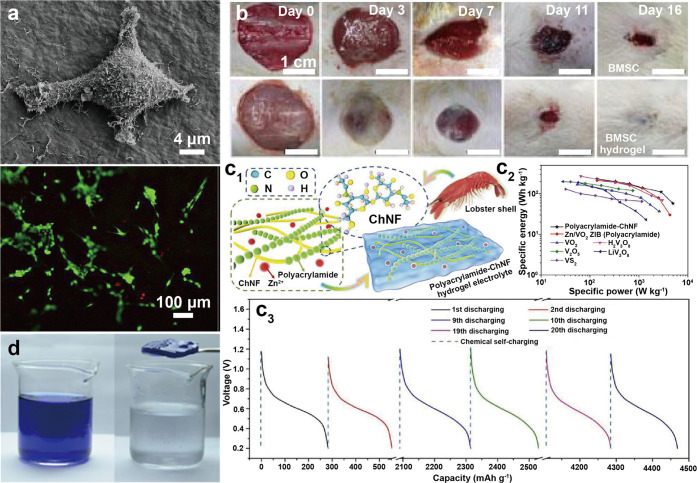Figure 36.
(a) SEM image (upper panel) and fluorescent micrograph (bottom panel) of osteoblast cells on alginate-containing ChNC hydrogel (ChNC/alginate ratio of 1). Adapted from ref (624). Copyright 2015 American Chemical Society. (b) Representative photos of cutaneous wounds treated with BMSCs alone and BMSC-encapsulated ChNF hydrogel, indicating the accelerated healing at all time points after incorporating BMSCs in the ChNF hydrogel. Adapted with permission from ref (644). Copyright 2018 John Wiley and Sons. (c1) Schematic showing of the preparation of a polyacrylamide-ChNF hydrogel that is suitable as the electrolyte in solid-state ZIB containing a VO2 cathode. (c2) Ragone plot of a Zn//VO2 solid-state battery using polyacrylamide-ChNF hydrogel electrolyte compared with other vanadium-based cathodes for an aqueous ZIB. The results indicate the high energy density of the current system. (c3) Galvanostatic discharging and chemical self-charging (oxidation for 6 h) cycles of solid-state ZIB. Twenty cycles were performed continuously, showing excellent self-rechargeability. Adapted with permission from ref (652). Copyright 2021 John Wiley and Sons. (d) Visual appearance of dyed water before and after treatment with a ChNF hydrogel. Reactive Blue 19 (90 mg/L) was fully adsorbed by the ChNF hydrogel (pH 1.5 after 12 h contact at 150 rpm stirring). Adapted from ref (620). Copyright 2016 American Chemical Society.

